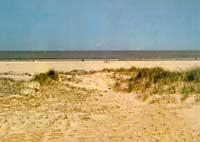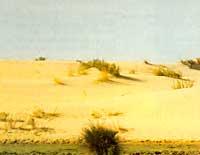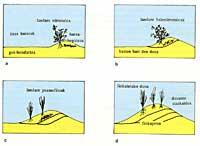Dunes; unknown sand hills
1986/12/01 Barandiaran, Mariaje | Irazabalbeitia, Inaki - kimikaria eta zientzia-dibulgatzaileaElhuyar Fundazioa Iturria: Elhuyar aldizkaria

Coastal dunes are a unique ecosystem. They constitute a system in dynamic equilibrium with the sea. Until now this equilibrium, although changing, was situated within the nature of nature. Today, due to the influence of man, balance has begun to break in many places. The protective function of the dunes, that is, one of its functions can disappear and the sand and cresal can begin to penetrate inland deteriorating the entire territory.
The dune is not a lot of sands that is in the same place for centuries. He leads his own life and is mobile and fragile. The sea gives him and takes away the sand, the sea winds push him back and the soil winds stop his retreat. The structure and durability of the dune depends on the plants that adhere to it. As there are more plants, the dune will be more consolidated. Therefore, whoever attacks the plant cover endangers the life of the dune.
Dunes are not just living elements of the coast. They have many functions. Besides being beautiful and spectacular, they are hard fences against storms and swallows. They cushion the force of the sea winds and greatly absorb their cresal. These protective actions protect the beach itself and the interior of the coast. Crops are profitably harvested with the protective effect of the dunes.

To explain the protective effect of the dune it is necessary to take into account the exchange between the beach and the beach. The front beach is unlined under the waves, but both are united forming a body. Being soft waves, they feed the dune and get fat. The waves dry very quickly and without force. They have a constructive effect during the summer. The hangover has a lesser force than the one that brings sand to the beach. The sediments submerged in the prebeach emerge on the beach and accumulate forming small slopes. The slope of the beach increases to the point where the contribution of sand and driving are matched.
When a wave collides with great force against a dune, its energy is spent by three. On the one hand it slows the smooth change of the dune. On the other hand, it slows the sand. Not being a rigid sand, it acts as a shock absorber. Finally, it reduces the strength of the coming water, absorbing water and mixing it with water.
Waves do not remove sand from the beach, but destabilize the foot of the dune. The foot of the dune behaves like a small cliff. If the dune cycle is stable, this negative effect is compensated in summer. The sand between high and low tides moves throughout the year. It is estimated that each year they travel 500 m 3 of sand per meter of beach.
The erosion/construction balance is only in balance when it provides the amount of sand that drags the sea. However, in some coastal areas there may be sediments from outside the beach system, as well as the presence of other sediments in permanent seas. Rivers are the engine of the first process and marine currents the second.
The effect of waves, tidal currents, deeper currents and winds come together to thaw the beach. In this aspect highlights the importance that the wind can have. When the speed of growth is greater than 15 km/h, it begins to drag fine sand of 0.2 mm in diameter. When the speed is 18 km/h, the wind can transport a kilogram of sand to a meter away for an hour. If the wind speed doubles, at 36 km/h, it can reach 100 kg.m/h. And a 72 km/h wind can carry 800 kg.m/h.
If the beach loses the amount of sediments it receives, it will remain. If what you receive is less than what you have taken, just when the sediment balance is negative, the beach will recede and the dunes come together. In a more or less long term, the beach disappears. If the sediment balance is positive, the beach will "grow". This beach will create mobile dunes that will be pushed by the wind inland. The dunes will be mobile due to the absence of fixing vegetation. The mobility of the dunes is usually a sign of their youth.
Plants are used for fixing dunes. These plants are usually resistant to cresal, such as the reed of the sands ( gropyrum junceum). These plants increase the roughness of the dune, decreasing the speed of the wind and depositing the sand it carries before. In this semi-stable dune then grow other plants that need sand to grow. They are known as psamophilous species and, among them, the most common is the postarenal (Ammophila arenaria).
After these pioneering plants the vegetation begins to be compacted, increasingly large and abundant. After them there are different vegetable associations: meadow scarce, little by little more compact and with simple bushes, meadow dotted with tamarind, tail and peas and finally a fairly open forest of form angiada, formed by pines, olives or oaks. Rain water can accumulate in some dune nooks, allowing the growth of reeds, reeds and in some cases willows.
This model referring to the colonization of vegetation has given rise to most of the fixed dunes we know today. The sand comes from the erosion associated with the freezing and thawing phenomena of glaciers during glaciations. When glaciers were more widespread 18,000 years ago, the sea level was 100 m below the current one. The subsequent climate warming continued to melt polar ice and sea level rise. Throughout this ascension, the sea worked and modeled the materials that were; from the blocks the songs were extracted and from these the caskets. Quartz grains became sands and thinner materials were extracted sludge... As it ascended, the sea easily transported all these materials.
Our current coast was formed five or six thousand years ago. Large amounts of mobile sediments accumulated at the edge. Among them were everything: thick and fine sand, songs and caskets.
The underwater sediment reserve has now been completed. The only important contribution comes from the erosion of rivers and seas. However, man's hand influences them very much. The extraction of marine sands, the canalization works, the dams in streams and rivers, the reservoirs and the harbour labors prevent the material eroded to a large extent to reach the beach. Thus, large rivers such as the Ebro or the Rhône emit four times less material than a century ago.
There is also another factor to consider. On the coasts facing the Atlantic Ocean the level of the itaso continues to rise at a speed of 1-2 mm/year.
The walls, hotels, roads or any other provision on which the dune is located are even more harmful for tourist use. They break the balance of the dune with the sea.
The dune is therefore a natural good that we must all preserve. So the Basques who are going to sunbathe towards Landeta try to protect the dunes: walking along the marked paths and not stepping on the plants that fix the dunes. In this way, our descendants can enjoy nature, like us.

Gai honi buruzko eduki gehiago
Elhuyarrek garatutako teknologia













